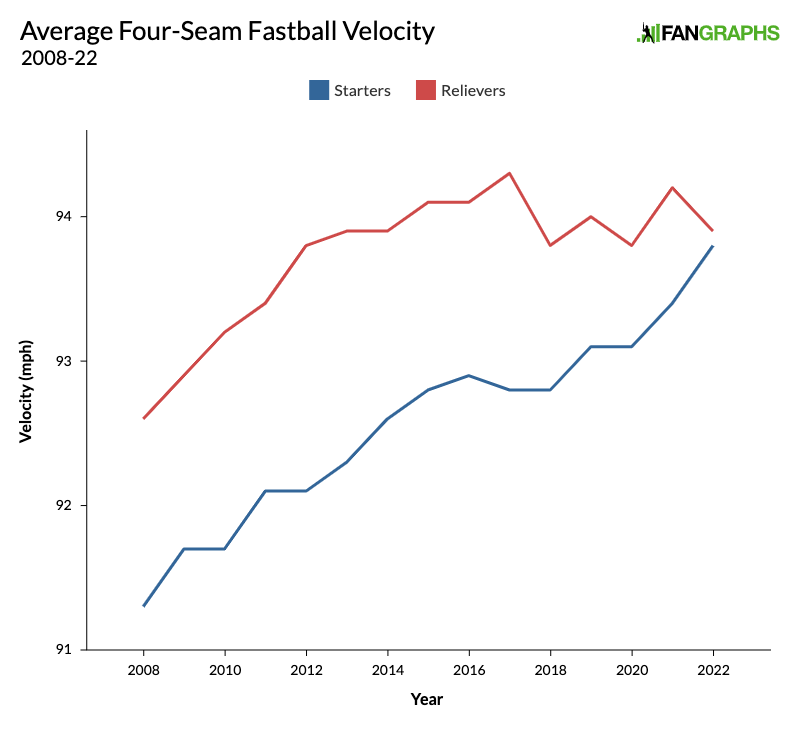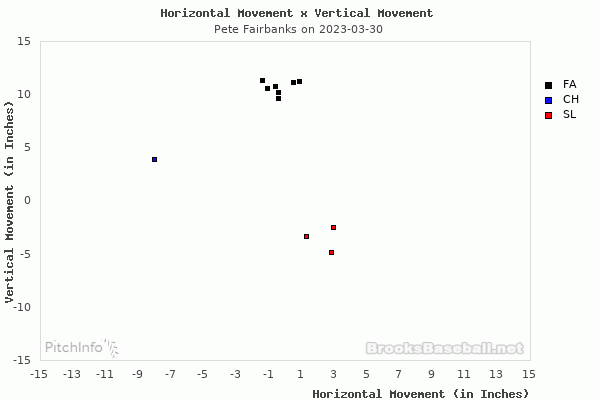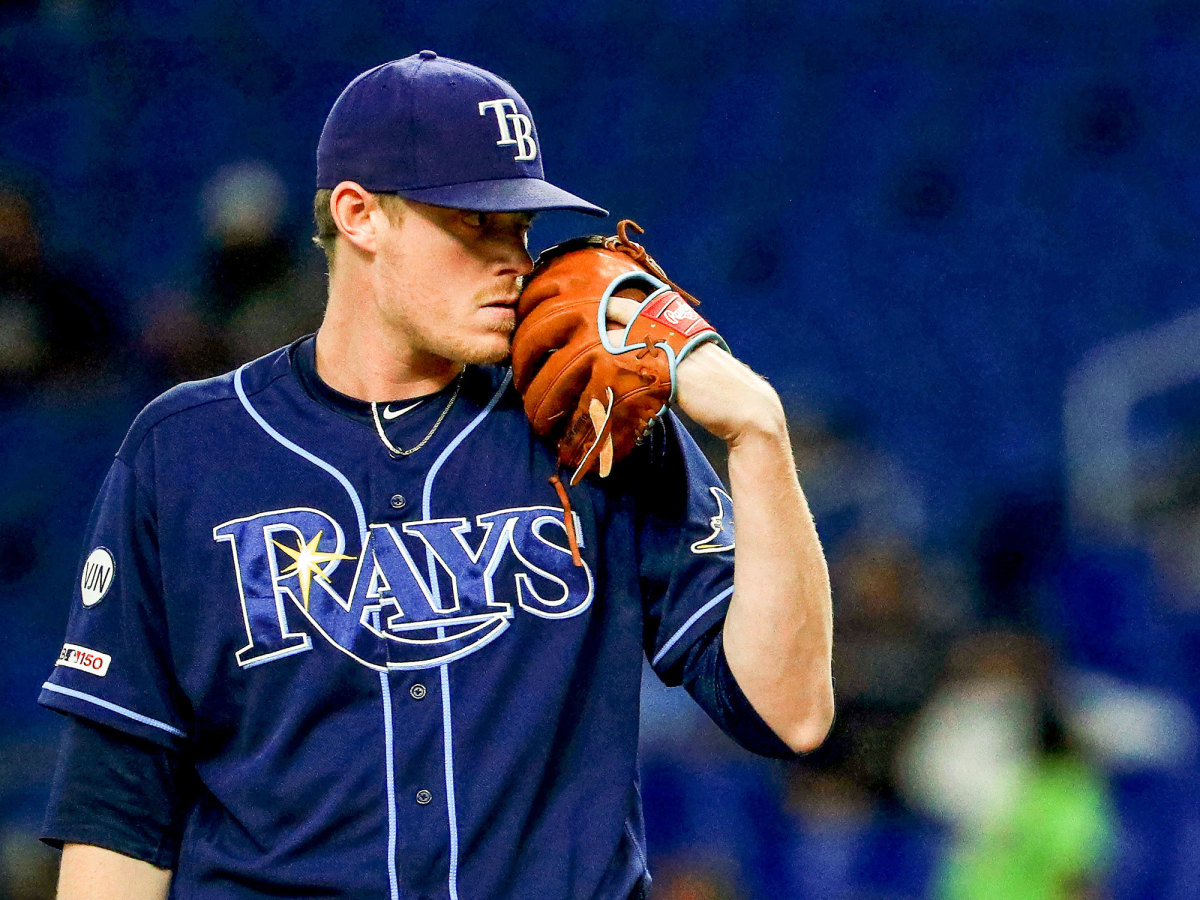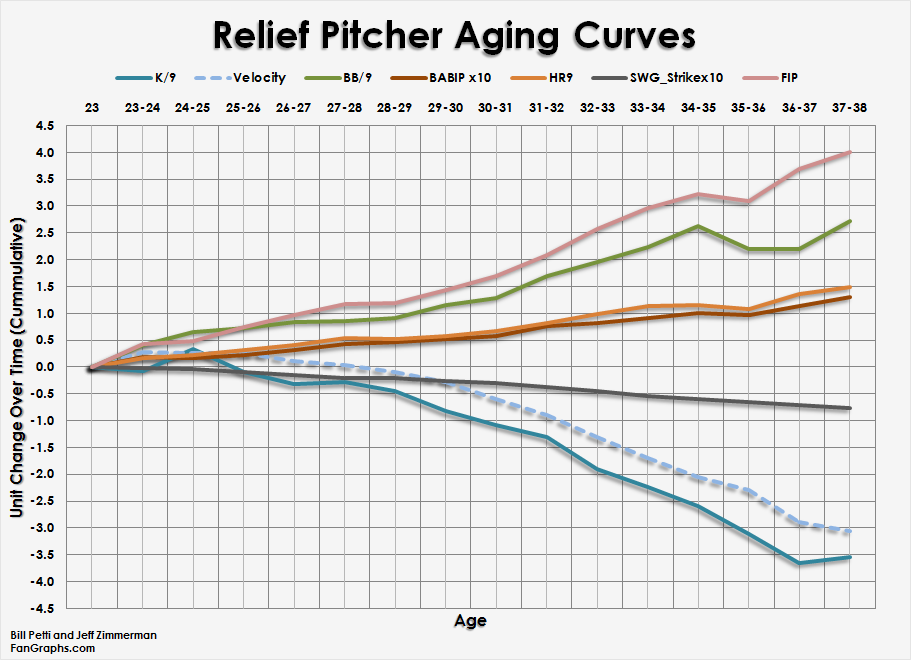Baseball has changed a lot over the last few decades. Even as recently as the early 2010s, pitchers with 100+ MPH fastballs were viewed as outliers with exceedingly rare and valuable skill. Now, we’re seeing guys with high-90s heat struggling to make major league rosters because of how common they’ve become. It’s no longer an event when we see “100” flash up on the scoreboard; we’ve just grown accustomed to it. Outliers are becoming harder and harder to come across as pitchers inch closer every year to the physical limitations of the human body.

With all of these flamethrowers popping up around the league, we need to look beyond the radar gun to find guys with truly exemplary pitches. We need to dig for pitch shapes, movement profiles, spin rates, and a whole slew of assorted metrics to get an idea of which pitchers rise to the top among their contemporaries. Now that all of this data is publicly available and players are becoming increasingly willing to implement modern pitch design into their routines, we’ve reached a point where it’s nigh impossible to throw a true outlier pitch.
If only there were a 6’6” relief pitcher from Milwaukee with the eyes of a serial killer and a fastball that broke nearly every publicly available stuff metric ever developed.
If only…

Pete Fairbanks somewhat quietly put together one of the most impressive stretches of pitching I’ve ever witnessed in my life following his return from a shoulder injury in late August of 2022. From his return to the end of the regular season, Fairbanks faced 37 batters over 10 games. He struck out 19 of them (51 K%), surrendered 3 hits (all singles), and walked 2 of them. His FIP during this run was 0.02.
He pitched in 24 games total last season, registering a 1.13 ERA, 0.67 WHIP, 43.7 K%, and a 1.17 xFIP. It doesn’t matter what metric you look at, Fairbanks’ 2022 campaign was just 24 innings of completely dismantling major league hitters. There were times when elite players were whiffing at consecutive pitches in the heart of the strike zone because of how characteristically ridiculous Fairbanks’ arsenal was.
Before we go too deep into that, however, let’s look back at the road Fairbanks took to get to this level of dominance.
The Path of Pistol Pete
Fairbanks was a 2015 9th-round draft pick by the Texas Rangers out of the University of Missouri. He made his major league debut with Texas on June 9th, 2019 against the Oakland Athletics, pitching 2 perfect innings of relief with 3 strikeouts. While he was drafted as a starter, it became clear pretty quickly that Fairbanks was destined for the bullpen given his two Tommy John surgeries, kicking off an injury record that haunts him to this day.
Perhaps the most important day of his early career came about three weeks after his debut, when he threw an inning against the Tampa Bay Rays on June 29th. While it wasn’t a great outing for Fairbanks, giving up 2 runs on a pair of solo home runs by Willy Adames and Travis d’Arnaud, the key was that he pitched in Tropicana Field in front of some particularly observant talent evaluators.
The Rays, 47-36 at the time and emerging as a perennial playoff contender, liked what they saw from Fairbanks. Despite giving up those two homers, he struck out the other three batters he faced in his lone inning of work and flashed an electric fastball and a wicked breaking ball.

Rays brass liked him so much, in fact, that they swung a trade for him two weeks after his appearance in Tampa Bay, sending former Yankees 2nd-round pick Nick Solak to the Rangers in a 1-for-1 deal. This trade falls pretty squarely in line with the Rays’ current pitching development model for relievers: find guys with ridiculous stuff, iron out their command, and get them comfortable attacking the strike zone. They clearly saw back-end reliever potential in Fairbanks, so they got aggressive and brought him on board.
It didn’t immediately get better after the trade for Fairbanks, as he finished the 2019 season putting up a 5.11 ERA and 1.62 WHIP in 13 appearances with the Rays. The early indications, however, were there. He started pounding the zone more, walking only 3 batters in his 12.1 innings. He even picked up 2 saves to close out the year despite his results, a display of faith on the Rays’ part.
The COVID-shortened 2020 season was Fairbanks’ first full year in Tampa Bay, and it was his first real stretch of success in the big leagues. He served as a late-innings weapon for the majority of the season, posting a 2.70 ERA, 33.3 K%, and 31.8 CSW%. His breakout year was highlighted by a 4-out save in game 7 of the ALCS against the reigning American League champion Houston Astros, striking out 3 batters to send the Rays to the World Series.
For the first time since 2008, your Tampa Bay Rays are heading to the World Series! pic.twitter.com/FBCVaji2xT
— Tampa Bay Rays (@RaysBaseball) October 18, 2020
Fairbanks still battled his command at times, walking a career-high 12.0% of the batters he faced. Still, it was a big step in the right direction. He greatly improved his ability to limit extra-base hits, slashing his opponent’s xSLG% from .469 in 2019 to a 90th-percentile .299.
The main adjustment he made was to flip the usage of his fastball and slider, increasing his fastball usage by about 13%. Given the Rays’ penchant for having guys throw their best pitch at high rates, this was an early signal that they thought very highly of the pitch.
2021 was pretty up and down for Fairbanks, but it came with his highest volume of work to date. He finished with a 3.59 ERA, 29.6 K%, and 31.7 CSW%, picking up 5 saves and 14 holds over his 47 games and 42.2 innings. He slightly improved his walk rate, but his strikeout rate saw a similar dip. It was a good season of relief work, but nothing spectacular.
That leads us to the 2022 season, which, as previously mentioned, was nothing short of transcendent. His season was so successful, that he was inked to a 3-year, $12M extension in the 2022-2023 offseason. On a rate basis, there was no better reliever in baseball than Fairbanks last season, and it was largely thanks to that completely unhittable fastball.
The Outlier Pitch
To kick off our discussion of Pete Fairbanks‘ four-seam fastball, I thought we might take a look at the best fastballs in baseball for the 2022 season according to PLA, the PLV pitch ERA estimator that grades pitches based on movement, velocity, location, and spin, among a variety of other factors.
Fairbanks didn’t just throw the best fastball in major league baseball last year. He threw the best fastball in baseball by a wide margin. The difference between the PLA scores for Fairbanks’ fastball and Jacob deGrom’s 2nd-place four-seamer (+0.78) is the same as the difference between deGrom and the 33rd-best fastball in baseball, Gerrit Cole. Let’s look at this pitch on the old boxplot to get an idea of how much of an outlier it really is.

…oh.
If we were to take the league-average fastball PLA and create a PLA- stat, where 100 is average and every point below 100 is a point above average, Fairbanks’ score would be 35. Needless to say, PLV is obsessed with this pitch.
If PLV isn’t your thing, Eno Sarris’ Stuff+ is a different model that incorporates many of the same factors as PLV, but arranges them differently and continuously trains data as it is accumulated. The recently-revamped Stuff+ model gives Fairbanks a 181.2 fastball score or about 82% above average. This was the best fastball recorded by the model, beating teammate Tyler Glasnow’s 168.9.
It was also the best singular pitch thrown by any pitcher with a minimum of 100 thrown in 2022, completely demolishing more well-known weapons like Emmanuel Clase’s cutter (159.2), Spencer Strider’s fastball (154.9), and Edwin Diaz’s slider (148.6). Let’s see what the boxplot thinks of that!

…oh.
Folks, we just might have an outlier on our hands! But what made it so vastly different from the plethora of other 100+ mph heaters thrown by other pitchers? Why did stuff models love this pitch so much that it essentially broke their scales?
Wicked Movement (Or Lack Thereof?)
The general public sentiment towards pitching is that more movement results in better pitches that are harder to hit. It just makes intuitive sense to us. We all drool over frisbee sweepers that have 20 inches of horizontal run and hammer curveballs that fall off the table 5 feet from the plate.
Because of this, logic would follow that Fairbanks’ four-seamer has some crazy movement on it. Maybe it has a ton of horizontal break that fools hitters? Maybe some sinker-like drop?
Nope! Pete Fairbanks throws the straightest fastball in the entire sport. No four-seamer has less vertical drop than Fairbanks’ 7.5 inches. It doesn’t have any crazy run or sharp break; it approaches the plate straight as an arrow. In fact, no four-seamer had less vertical or horizontal break than his in 2022. This might seem like a problem at first, but it’s actually the entire reason the pitch was so effective last year.
There have been numerous studies into the Magnus effect, the perceived movement of a baseball from the hitter’s view, and its effect on performance against different fastballs, but I’m going to simplify it as much as possible here. Essentially, the less a fastball “drops” as it approaches the hitter, the more it appears to actually “rise”, creating unique perceived movement that can cause hitters to consistently swing under the pitch.
By killing more vertical drop than any other pitcher and generating a huge amount of backspin, Fairbanks throws a fastball that seems to defy gravity and rise on its way to the plate. This can be quantified by induced vertical break, which has Fairbanks generating more than 20 inches of IVB on his fastball.

The way this pitch holds its plane to an almost impossible extent and the velocity it registers (99 MPH on average in 2022) give Pistol Pete’s fastball a one-of-a-kind shape that clearly overwhelmed hitters. A movement profile this skewed towards vertical break and away from horizontal run keeps Fairbanks’ four-seamer light-years outside of the dreaded “flat zone” and in a category of its own.
Put simply, we’ve never seen a pitch quite like this in the statcast era, if not the entire history of major league baseball. Since 2017, here are the four-seam fastballs with the least amount of vertical break in a single season and their average velocity.
Fairbanks was the sole pitcher in 2022 to throw a fastball that averaged 99+ MPH and more than 20” IVB, making it a truly one-of-a-kind pitch with unprecedented shape. Nobody has had this combination of velocity and rise since we started religiously tracking statcast pitch data in 2017.
And he’s not looking to make 2022 a one-time thing, either. We just saw Fairbanks take the mound for an inning on opening day against the Tigers, and while he didn’t register any strikeouts, he averaged 8 inches of vertical break on the four-seamer and threw two fastballs to Nick Maton with a measly 6 inches of drop.

I’ve always thought that one of the great tragedies of modern baseball technology is that it wasn’t introduced sooner. There have been so many pitchers in baseball history with fantastic arsenals that will go completely undocumented by the modern evaluation tools we use today. While we intuitively know that guys like Nolan Ryan and Randy Johnson had incredible fastballs in their primes, we’ll never be able to truly stack those pitches up with those thrown by modern players.
In the name of fairness, I can’t confidently say that Pete Fairbanks is throwing a fastball with a combination of rise and velocity that has never been achieved in baseball history. I can say, however, that Fairbanks’ fastball is a unicorn among those recorded in modern baseball history. Given how much harder pitchers throw and how much data they can leverage nowadays, it’s probably safe to assume that his four-seamer belongs to an extremely exclusive group throughout the annals of baseball.
But Wait, There’s More!
With all this talk about the Fairbanks fastball, it’s easy to forget that he does, in fact, throw other pitches. Well, one other pitch really. His slider is a deadly weapon in its own right, although I’m not quite sure “slider” is the proper term here.
The shape of the pitch is more reminiscent of a curveball, dropping nearly 50 inches with only 2.5 inches of sweep. Regardless, the pitch is effective, registering a .181 opponent’s xwOBA and 37.1 CSW%.

Now Fairbanks would be just fine if he decided to only work with that FF/SL mix for the rest of his career. Honestly, he could probably only throw the fastball for the rest of his career and still get good results.
Here’s the kicker, though: there are signs Pete may be adding another pitch to his arsenal this season.
It looks like Pete Fairbanks is working on a splitter… and it's beyond filthy. #Rays
He's separating it from his four-seam by about 11" (of induced vertical break), but it's only ~4 mph slower, elite CH/SPL territory.
Here's the only pair we have on video right now: pic.twitter.com/z2ytaNXDva
— Lance Brozdowski (@LanceBroz) March 20, 2023
As Lance mentions in his tweet, this proto-splitter Fairbanks may be developing has 11” IVB separation and about 4 MPH velocity separation from his fastball, which is characteristic of the best fastball/split-change duos in the entire sport. For reference, Orioles reliever Felix Bautista was working with a FF/FS combo with just under 13 inches of IVB separation in 2022, and that particular pair was considered the gold standard for this profile last year. If Fairbanks can even approach that number…oh boy.
Just think about this for a second. A guy with a 99-MPH fastball that already rises more than 20 inches as it approaches the plate is now equipped with a 93-95 MPH splitter that is separated from that fastball by almost an entire foot. As a hitter, you’re not just worried about whether the already-unhittable fastball or the pseudo-curveball is coming anymore. You now have to worry about whether the fastball or slider is coming, and whether that fastball is going to rise 20 inches or dive off the table.
This is just horrifying stuff as a hitter, almost as horrifying as the glare Fairbanks gives the hitter before they even begin to worry about hitting him. Those eyes might just add another few MPH of perceived velocity alone.

Mike Ehrmann/Getty Images
Appreciating Pete
Pete Fairbanks represents everything that’s fun about modern baseball. He’s an outlier in more ways than just his height. He’s an outlier in his stuff, his personality, and his mound presence.
In the grand scheme of baseball history, it’s been pretty easy to identify outliers among position players just by watching the game. Everybody could tell that Barry Bonds had freakish power, or Ricky Henderson had superhuman speed. With pitchers in modern baseball, however, it can be hard to tell who is rewriting history. Especially relief pitchers.
Modern relievers have the shortest careers of any other player on an MLB roster. They exert maximum effort and push the very limits of the human body over shorter amounts of time, which can often lead to injury and early decline compared to starting pitchers and position players. The relief pitcher is the Icarus of baseball, flying as close to the sun as possible while trying not to burn.

With so many guys lighting up the radar gun, we can grow a bit numb to it and neglect the incredible amount of skill and training it takes to throw a ball with that much force. We have to dig into the more detailed numbers to really see who stands out.
And boy, does Pete Fairbanks stand out.
So, here’s my plea to you. The next time you’re flipping through baseball games and you happen to land on a Rays game in which Fairbanks is either on the mound or warming up, just stop what you’re doing and watch. Know that with every fastball he throws, you’re watching something that has, at the very least, not been seen in half a decade.
There is a chance, however, that you’re watching this 29-year-old in the prime of his career throw a fastball that is completely and entirely unique in baseball history. Don’t take that for granted.



Fairbanks has historically poor command. I really do think that there have always been guys that could throw like he does but they didn’t get MLB run. He is just a freak show but this is the era of generating data as opposed to playing baseball. Maybe he learned to pitch while injured. Its possible. For me, he is the epitome of why baseball is trash. Rather than a pitcher who can pitch it is some RP who closes his eyes and hopes for a strike. Lucky for him modern hitters are not prepared. Their preparation was a brief glance at a tablet and some BP where they also shut their eyes and swung as hard as they could for 10 pitches hoping to generate some sick EV. Its a all a vicious cycle.
Before you get too excited about velocity you should consider that MLB and AWS have every incentive to juice the numbers. Just a few years ago they changed how they measure velocity. I mean MLB flat-out juiced baseballs just a few years ago and lied about it. They conducted their own investigation and found no evidence that balls were juiced. MLB has zero credibility and there is no reason to take any of their data seriously in a historic context. Every one of those 100s could be 95s and we would never know the difference.
He had 3 walks and 38 k’s last year, idiot. They wouldn’t bother writing an article about a guy with no command.